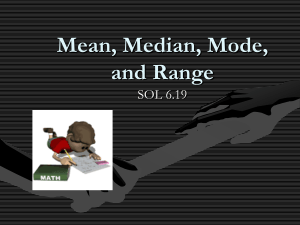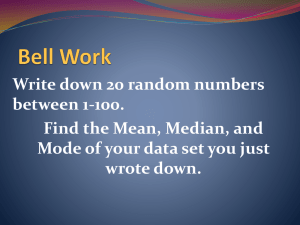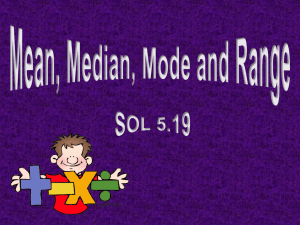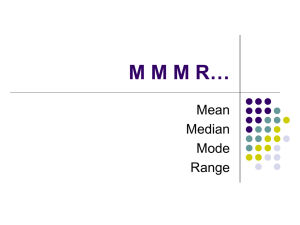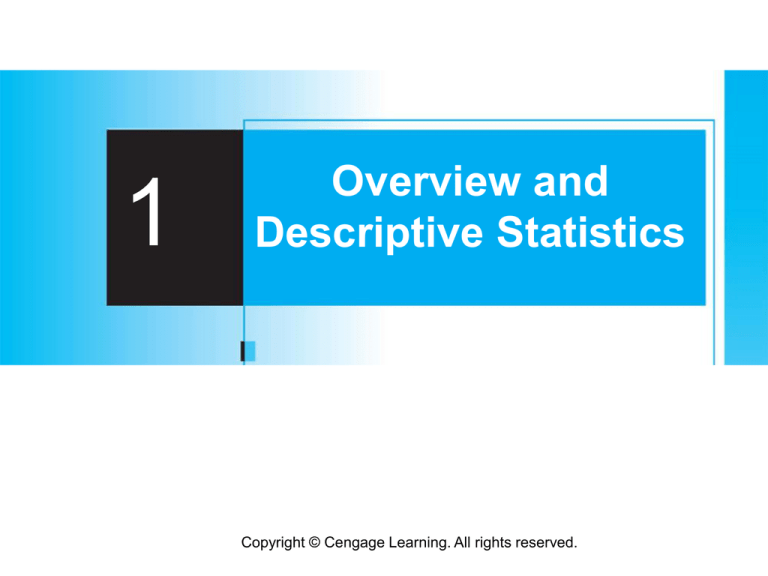
1
Overview and
Descriptive Statistics
Copyright © Cengage Learning. All rights reserved.
1.3
Measures of Location
Copyright © Cengage Learning. All rights reserved.
Measures of Location
More formal data analysis often requires the calculation
and interpretation of numerical summary measures.
Measurements that characterize the data set and convey
some of its salient features.
Focus on numerical data primarily, a little categorical data
at the end.
Two important location measures are both for the center:
Mean
and
Median
3
The Mean
4
The Mean
For a given set of numbers x1, x2,. . ., xn, the most familiar
and useful measure of the center is the mean, or arithmetic
average of the set.
The sample mean x of observations x1, x2,…, xn, is
Recommend using decimal accuracy of one digit more than
the accuracy of the xi’s.
5
Example 14
x1 = 16.1
x6 = 21.2
x11 = 25.3
x16 = 24.2
x21 = 28.5
x2 = 9.6
x7 = 30.2
x12 = 14.0
x17 = 14.6
x3 = 24.9 x4 = 20.4 x5 = 12.7
x8 = 25.8 x9 = 18.5 x10 = 10.3
x13 = 27.1 x14 = 45.0 x15 = 23.3
x18 = 8.9
x19 = 32.4 x20 = 11.8
With xi = 444.8, the sample mean is
The mean as the balance point for a system of weights
6
The Mean for population
The population mean, , is the average of all population
values, = (Σ N values)/N, for a finite population of size N.
Later for statistical inference, we will learn methods based on
the sample mean to draw conclusions for a population mean.
For example, we can use the sample mean x = 21.18
computed in Example 14 as a point estimate of = crack
length for all specimens.
7
The Mean: one weakness
One deficiency to measure center: Its value can be greatly
affected by an outlier (unusually large or small observation).
In Example 14, x14 = 45.0.
Without x14, x = 399.8/20 = 19.99; the outlier increases the
mean by more than 1 m. If the 45.0 m observation were
replaced by the catastrophic value 295.0m a really extreme
outlier, then
x = 694.8/21 = 33.09,
which is larger than all but one of the observations!
8
The Mean
A sample of incomes often produces such outlying values
(those lucky few who earn astronomical amounts), and the
use of average income is often misleading.
There is a measure that is less sensitive to outlying values
than x, the median.
However, the mean is still the most widely used measure,
because there are many populations that don’t have
extreme outliers in the sample often.
Sampling from such a population (a normal or bell-shaped
population), the sample mean will tend to be stable and
quite representative of the sample.
9
The Median
10
The Median
The sample median, is the middle value once the
observations are ordered from smallest to largest, for x1≤ x2
≤…, ≤ xn.
11
Example 15
cont’d
A sample of 12 recordings of Beethoven’s Symphony #9,
yielding the following durations (min) listed ascendingly:
62.3 62.8 63.6 65.2 65.7 66.4 67.4 68.4 68.8 70.8 75.7 79.0
Median: 66.9
Mean: 816.1/12
= 68.01
Figure 1.16 Dotplot of the data from Example 14
n = 12, the sample median is the average of the 6th and 7th
values from the ordered list:
Had the largest observation 79.0 not been there, the resulting
sample median for the n = 11 remaining observations would
12
have been the single middle (6th) value 66.4.
The Median
The data in Example 15 illustrates an important property of
in contrast to x: The sample median is insensitive to
outliers. If, for example, we increased the two largest xis
from 75.7 and 79.0 to 85.7 and 89.0, respectively,
would be unaffected.
Thus, in the treatment of outlying data values, x and
are
at opposite ends of a spectrum. Both measures describe
where the data is centered, but they will not in general be
equal because they focus on different aspects of the
sample.
13
The Median
Analogous to as the middle value in the sample is a
middle value in the population, the population median,
denoted by
As with and , we can think of using the
sample median to make an inference about
In Example 15, we might use = 66.90 as an estimate of
the median time for the population of all recordings. A
median is often used to describe income or salary data
(because it is not greatly influenced by a few large
salaries).
14
The Median
The population mean and
median will not generally be
identical. If the population distribution is positively or
negatively skewed, as pictured in Figure 1.17, then
(a) Negative skew
(b) Symmetric
(c) Positive skew
Three different shapes for a population distribution
Figure 1.17
When this is the case, in making inferences we must first
decide which of the two population characteristics is of
greater interest and then proceed accordingly.
15
Other Measures of Location: Quartiles,
Percentiles, and Trimmed Means
16
Other Measures of Location: Quartiles, Percentiles, and Trimmed Means
The median (population or sample) divides the data set into
two parts of equal size. To obtain finer measures of
location, we could divide the data into more than two such
parts.
Roughly speaking, quartiles divide the data set into four
equal parts, with the observations above the third quartile
constituting the upper quarter of the data set, the second
quartile being identical to the median, and the first quartile
separating the lower quarter from the upper three-quarters.
17
Other Measures of Location: Quartiles, Percentiles, and Trimmed Means
Similarly, a data set (sample or population) can be even
more finely divided using percentiles; the 99th percentile
separates the highest 1% from the bottom 99%, and so on.
Unless the number of observations is a multiple of 100,
care must be exercised in obtaining percentiles.
18
Other Measures of Location: Quartiles, Percentiles, and Trimmed Means
The mean is quite sensitive to a single outlier, whereas the
median is impervious to many outliers. Since extreme
behavior of either type might be undesirable, we briefly
consider alternative measures that are neither as sensitive
as nor as insensitive as .
To motivate these alternatives, note that
and are at
opposite extremes of the same “family” of measures.
The mean is the average of all the data, whereas the
median results from eliminating all but the middle one or
two values and then averaging.
19
Other Measures of Location: Quartiles, Percentiles, and Trimmed Means
To paraphrase, the mean involves trimming 0% from each
end of the sample, whereas for the median the maximum
possible amount is trimmed from each end.
A trimmed mean is a compromise between and . A
10% trimmed mean, for example, would be computed by
eliminating the smallest 10% and the largest 10% of the
sample and then averaging what remains.
20
Example 16
Consider the following observations on copper content (%)
for a sample of alloy:
2.0 2.4 2.5 2.6 2.6 2.7 2.7 2.8 3.0 3.1 3.2 3.3 3.3
3.4 3.4 3.6 3.6 3.6 3.6 3.7 4.4 4.6 4.7 4.8 5.3 10.1
Outlier
Figure 1.18
Dotplot of copper contents from Example 16
The sample mean and median are 3.65 and 3.35,
respectively. A trimmed mean with a trimming percentage
of 100(2/26) = 7.7% results from eliminating the two
smallest and two largest observations;
21
Trimmed Mean: when desired % is not integer
If the desired trimming percentage is 100 % and n is not
an integer, the trimmed mean must be calculated by
interpolation. For example, consider = .10 for a 10%
trimming percentage and n = 26 as in Example 16.
Then xtr(10) would be the appropriate weighted average of
the 7.7% trimmed mean calculated there and the 11.5%
trimmed mean resulting from trimming three observations
from each end.
22
Categorical Data and Sample
Proportions
23
Categorical Data and Sample Proportions
When the data is categorical, the natural numerical summary
quantities are the individual frequencies and the relative
frequencies.
A dichotomous population—one having only two categories.
If we let x denote the number in the sample in category 1 (the
one we are more interested), then the number in category 2 is
n – x. The relative frequencies or sample proportions in
categories 1 and 2 are x/n and 1 – x/n.
24
Categorical Data and Sample Proportions
Let’s denote a response that falls in category 1 by a 1 and
a response that falls in category 2 by a 0. A sample size of
n = 10 might then yield the responses 1, 1, 0, 1, 1, 1, 0, 0,
1, 1. The sample mean for this numerical sample is:
Then the sample proportion of observations in the category
is the sample mean of the sequence of 1s and 0s. Thus a
sample mean can be used to summarize the results of a
categorical sample.
25
Categorical Data and Sample Proportions
Analogous to the sample proportion x/n of individuals or
objects falling in a particular category, let p represent the
proportion of the entire population falling in the category.
As with x/n, p is also between 0 and 1, and while x/n is a
sample characteristic, p is a population characteristic.
The relationship between the two parallels the relationship
between and , and between x and . In particular, we
will subsequently use x/n to make inferences about p.
26
Categorical Data and Sample Proportions
With k categories (k > 2), we can use the k sample
proportions to answer questions about the population
proportions p1,. . . ., pk.
27


